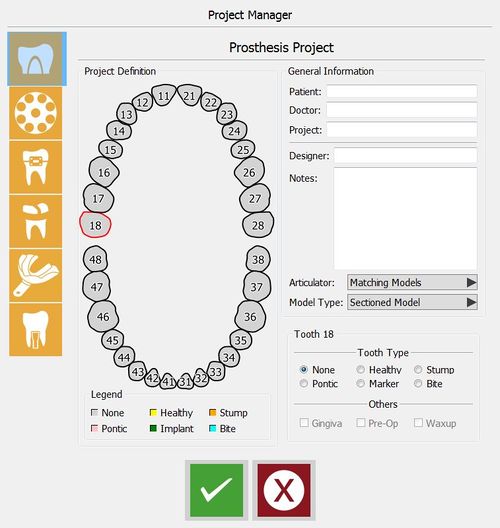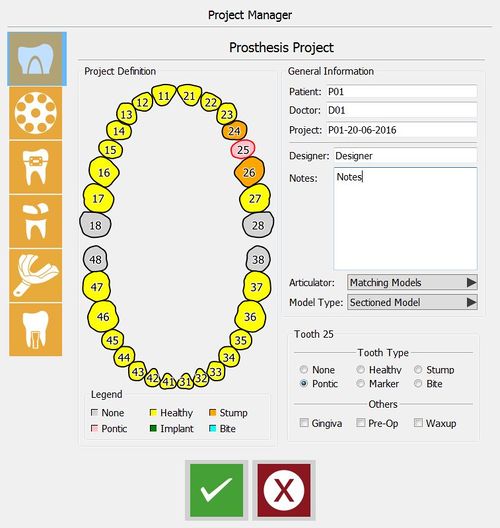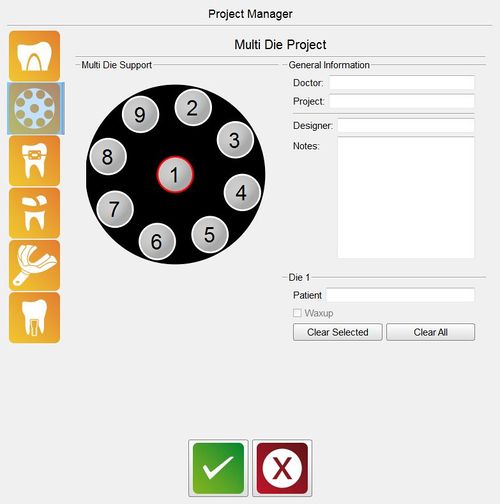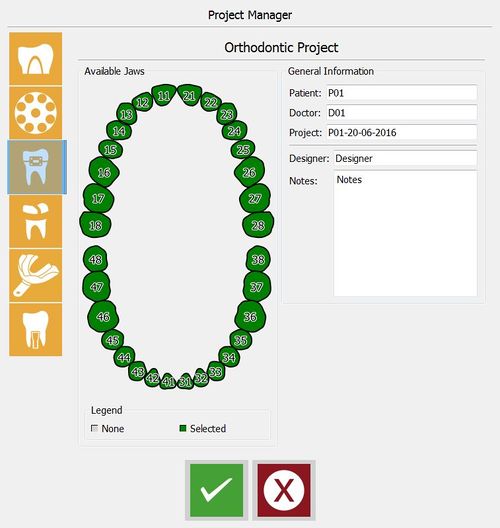Project Creation
Contents
Projekt
Wenn die Software direkt vom Nutzer gestartet wird und das Scanprojekt noch nicht in einer externen Software – wie z.B.: DentalDB von Exocad – ausgewählt worden sein, muss der Nutzer es definieren.
Die Software hat ein Projektdefinitionsfenster, in dem alle wichtigen Informationen zu den Scanelementen gesammelt werden. Je nach Informationstyp wird der Wizard gestartet.
Bei der Projektdefinition ist es möglich, eine der drei verfügbaren Projektarten mit einem Klick auf die jeweiligen Icons in der linken Leiste auszuwählen.
Alle Projektarten benötigen einige allgemeine Informationen:
- Name des Patienten (verpflichtend)
- Nummer des Arztes (optional)
- Einen Projektname für das Speichern auf der Festplatte; wenn nicht vorhanden, erstellt die Software einen automatisierten Projektname nach der Patient-ID.
- Name des Technikers (optional)
- Anmerkungen (Optional)
Um die Projektdefinition zu bestätigen, klicken Sie auf das grüne Icon im unteren Fensterteils. Die Software wird ein Strukturprojekt erstellen und den Wizard starten.
Prothesenprojekt
Durch Klicken auf das Icon wird die Definition eines Prothesenprojektes gestartet.
Dies ist der komplexeste Softwarebereich, weil hier eine viel höhere Informationsmenge als bei jedem anderen Projekt eingegeben werden kann. Es ist daher wichtig, jede Zahn einzeln zu definieren.
Zu den Allgemeinen Informationen enthält das Prothesenprojekt weitere zwei Bereiche:
Projektdefinition
Der breiteste Teil des Fensters zeigt ein Odontogramm, über das es möglich ist, die zu scannenden Elemente zu definieren.
Um den Elementtyp mit den jeweiligen Eigenschaften auf eine andere Zahn zu kopieren, klicken und halten Sie die Zahnnummer und ![]() gedrückt
gedrückt
Um den Elementtyp mit den jeweiligen Eigenschaften auf mehrere, aufeinanderfolgenden Zähne zu kopieren, klicken und halten Sie die jeweilige Zahnnummer und ![]() gedrückt
gedrückt
Elementinformationen
Für jedes Element können im unteren rechten Bereich der Zahntyp sowie einige Zusatzinformationen unter Mehr ausgewählt werden:
- Null
- dieser Zahn ist nicht Teil des Projekts, daher wird er nicht gescannt bzw. wird ignoriert
- Gesund
- dieser Zahn ist Teil des Hauptmodelles und wird mit allen anderen Modellteilen gescannt
- Zahnstumpf
- Dieser Zahn ist ein entfernbarer Zahnstumpf und wird einzeln oder auf dem Multi-Die-Halter gescannt
- Mittelzahn
- Fehlender Zahn zwischen zwei Stümpfen, wird das Mittelelement einer Zahnbrücke
- Scanbody
- an dieser Stelle wurde ein Implantat eingesetzt und ein Scanbody mit seinen Informationen wird analysiert werden
- Gebiss
- dieser Zahn ist Teil einer Okklusion (Gebiss)
Every tooth type has a specific color in the project definition scheme.
The Other Options are:
- Gingiva
- this element is mounted on an artificial gingiva that has to be acquired separately from the stone model
- Pre-Op
- the anatomy of this element is part of an additional model that will be acquired separately and then aligned to the reference stone model
- Waxup
- over this tooth position, it's possible to scan a Pre-Modelled Waxup that will be aligned to the rest of the stone model
Additional Parameters
In the general information section, there are some additional parameters:
Articulator Box
Select how the models are kept in articulation:
- Matching models
- to scan the occlusion if there is no need to use the automatic positioning in Exocad's Virtual Articulator
- Articulator A
- to scan the Artex Articulator and to use the same in Exocad's Virtual Articulator
- Articulator S
- to scan the Sam Articulator and to use the same in Exocad's Virtual Articulator
- Articulator P
- to scan the Kavo Articulator and to use the same in Exocad's Virtual Articulator
Model Type Box
Select which specific workflow to use:
- Sectioned Model
- default workflow, in which every element is acquired separately and all the information gets merged at the end
- Impression Scan
- if the Impression Scan Module is enabled in the license, check this option to scan an impression and not a stone model
- All In One
- if the All In One Scan Module is enabled, it is possible to scan all the parts of a Quadrant Trye in just one step
- Unsectioned Model
- enable this option if the model to be scanned is not sectioned, the scanner will not require a separate scan for every die
Here below an example of a defined prosthesis project for a 3-elements bridge with a stone antagonist:
Multi-Die Project
Use the Multi-Die Project to scan different dies from different patients in one single project:
To set the case, click on each multi-die position and define the name of each patient in the Patient field.
Orthodontic/Scheletric/Impression Project
The Orthodontic, Scheletric and Impression Projects are straightforward and similar to one another.
These projects require the user to select the whole jaws instead of individual teeth.
When the project definition is confirmed, the software will prepare the Project Tree to acquire the data from the scanner.
Project Editing
If the project definition needs to be changed while already in use, it is possible to select the Edit Project tool in the File Menu or in the Project Toolbar (See Support Toolbars And Menus).
This tool will open again the Project Manager with the current project definition. It is possible to change the project definition and the parameters of every tooth.
When the editing is confirmed, the software will adapt the Project Tree. Editing an already scanned, or partially scanned, project can cause data loss.






